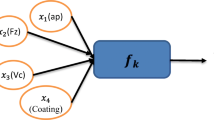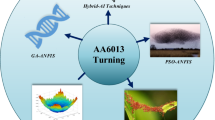Abstract
The objective of this study is to examine the influence of machining parameters on surface finish in turning of medical steel. A new approach in modeling surface roughness which uses design of experiments is described in this paper. The values of surface roughness predicted by different models are then compared. Used were adaptive-neuro-fuzzy-inference system (ANFIS). The results showed that the proposed system can significantly increase the accuracy of the product profile when compared to the conventional approaches. The results indicate that the design of experiments with central composition plan modeling technique can be effectively used for the prediction of the surface roughness for medical steel difficult to machining. Optimizations of surface roughness parameters was done by use of ant colony method.
Access this chapter
Tax calculation will be finalised at checkout
Purchases are for personal use only
Similar content being viewed by others
References
Chen, J.C., Savage, M.: A fuzzy-net-based multilevel in-process surface roughness recognition system in milling operations. Int. J. Adv. Manuf. Technol. 17, 670–676 (2001)
Quintana, G., Garcia-Romeu, M.L., Ciurana, J.: Surface roughness monitoring application based on artificial neural networks for ball-end milling operations. J. Intell. Manuf. 22, 607–617 (2009)
Sivarao, Castillo, Taufik: Machining quality predictions: comparative analysis of neural network and fuzzy logic. Int. J. Electr. Comput. Sci. IJECS 9, 451–456 (2000)
Drégelyi-Kiss, Á., Horváth, R., Mikó, B.: Design of experiments (DOE) in investigation of cutting technologies, Development in Machining Technology DIM, Cracow, pp. 20–34 (2013)
Maňková, I., Vrabeľ, M., Beňo, J., Kovač, P., Gostimirovic, M.: Application of Taguchi method and surface response methodology to evaluate of mathematical models for chip deformation when drilling with coated and uncoated twist drills. Manuf. Technol. 13(4), 492–499 (2013)
Hadi, Y., Ahmed, S.G.: Assessment of surface roughness model for turning process. In: Knowledge Enterprise: Intelligent Strategies in Product Design, Manufacturing, and Management. International Federation for Information Processing (IFIP), vol. 207, pp. 152–158 (2006)
Chen, C.C., Chiang, K.T., Chou, C.C., Liao, Y.C.: The use of D-optimal design for modeling and analyzing the vibration and surface roughness in the precision turning with a diamond cutting tool. Int. J. Adv. Manuf. Technol. 54, 465–478 (2011)
Choudhary, A., Harding, J., Tiwari, M.: Data mining in manufacturing: A review based on the kind of knowledge. J. Intell. Manuf. 20(5), 501–521 (2009)
Grzenda, M., Bustillo, A., Zawistowski, P.: A soft computing system using intelligent imputation strategies for roughness prediction in deep drilling. J. Intell. Manuf. 23, 1733–1743 (2012)
Balic, J., Korosec, M.: Intelligent tool path generation for milling of free surfaces using neural networks. Int. J. Mach. Tools Manuf. 42, 1171–1179 (2002)
Pérez, C.J.L.: Surface roughness modeling considering uncertainty in measurements. Int. J. Prod. Res. 40(10), 2245–2268 (2002)
Azouzi, R., Gullot, M.: On-line prediction of surface finish and dimensional deviation in turning using neural network based sensor fusion. Int. J. Mach. Tools Manuf. 37(9), 1201–1217 (1997)
Ho, S.Y., Lee, K.C., Chen, S.S., Ho, S.J.: Accurate modeling and prediction of surface roughness by computer vision in turning operations using an adaptive neuro-fuzzy inference system. Int. J. Mach. Tools Manuf. 42(13), 1441–1446 (2002)
Zębala, W., Gawlik, J., Matras, A., Struzikiewicz, G., Ślusarczyk, Ł.: Research of surface finish during titanium alloy turning. Key Eng. Mater. 581, 409–414 (2014)
Rajasekaran, T., Palanikumar, K., Vinayagam, B.K.: Application of fuzzy logic for modeling surface roughness in turning CFRP composites using CBN tool. Prod. Process. 5(2), 191–199 (2011)
Savković, B., Kovač, P., Gerić, K., Sekulić, M., Rokosz, K.: Application of neural network for determination of cutting force changes versus instantaneous angle in face milling. J. Prod. Eng. 16(2), 25–28 (2013)
Kundrák, J., Varga, G.: Use of coolants and lubricants in hard machining. Tech. Gaz. 20(6), 1081–1086 (2013)
Kovac, P., Rodic, D., Pucovsky, V., Savkovic, B., Gostimirovic, M.: Application of fuzzy logic and regression analysis for modeling surface roughness in face milling. J. Intell. Manuf. 24(4), 755–762 (2013)
Jang, J.S.R., Sun, C.T.: Neuro-fuzzy modeling and control. Proc. IEEE 83, 378–406 (1995)
Ying, L.C., Pan, M.C.: Using adaptive network based fuzzy inference system to forecast regional electricity loads. Energy Conversat. Manag. 49, 205–211 (2008)
Avci, E.: Comparison of wavelet families for texture classification by using wavelet packet entropy adaptive network based fuzzy inference system. Appl. Soft Comput. 8, 225–231 (2008)
Dorigo, M., Maniezzo, V., Colorni, A.: Ant system: optimization by a colony of cooperating agents. IEEE Trans. Syst. Man Cybern. Part B Cybern. 26(1), 29–41 (1996)
Acknowledgements
The paper is the result of the research within the project TR 35015 financed by the ministry of science and technological development of the Republic of Serbia and CEEPUS project.
Author information
Authors and Affiliations
Corresponding author
Editor information
Editors and Affiliations
Rights and permissions
Copyright information
© 2020 Springer Nature Switzerland AG
About this paper
Cite this paper
Kovač, P. et al. (2020). Modelling and Optimization of Surface Roughness Parameters of Stainless Steel by Artificial Intelligence Methods. In: Durakbasa, N., Gençyılmaz, M. (eds) Proceedings of the International Symposium for Production Research 2019. ISPR ISPR 2019 2019. Lecture Notes in Mechanical Engineering. Springer, Cham. https://doi.org/10.1007/978-3-030-31343-2_1
Download citation
DOI: https://doi.org/10.1007/978-3-030-31343-2_1
Published:
Publisher Name: Springer, Cham
Print ISBN: 978-3-030-31342-5
Online ISBN: 978-3-030-31343-2
eBook Packages: EngineeringEngineering (R0)




